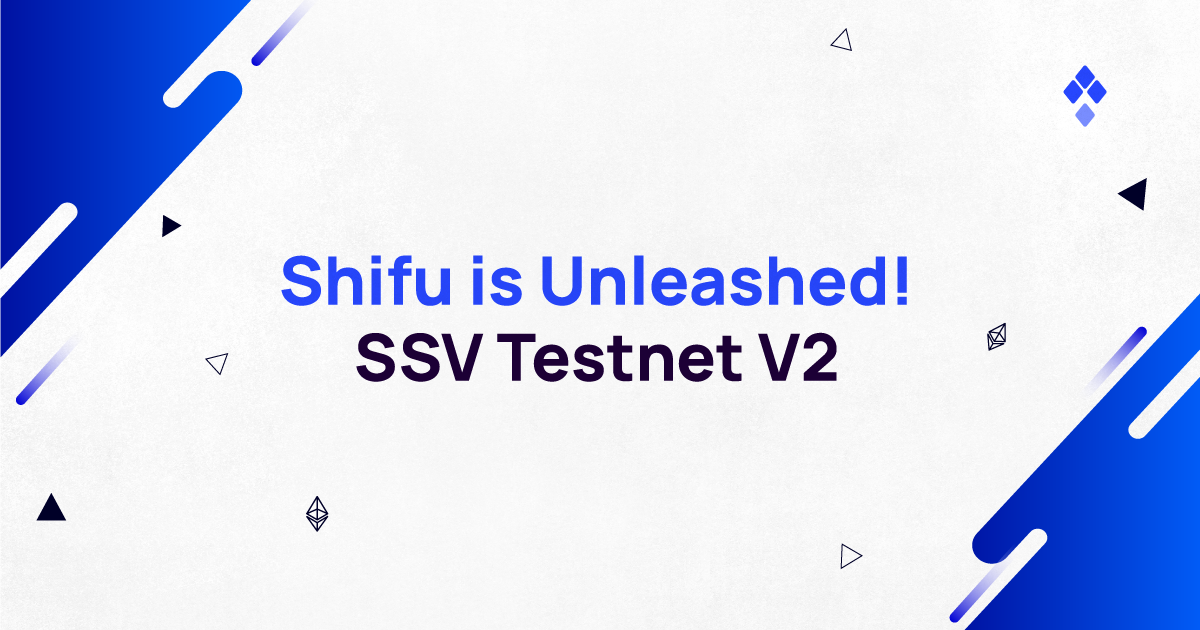Shifu SSV Testnet V2 — Live: 22nd of August!
The Shifu Testnet is almost live! Get a quick overview of all the new updates the team has added and how you can test out the latest in DVT.
As we get closer to the launch day we’ll be giving you a quick glance at our impending V2 Testnet and how to join.

After running the first public testnet, Shifu has been unleashed as the brainchild of 15 months worth of network testing, R&D, and development efforts. The SSV Core team has been actively working on Shifu for the past 8 months and with its release, we will be providing the foundational layer that enables the ecosystem to build truly distributed staking applications.
With SSV’s permissionless implementation of Distributed Validator Technology (DVT) nearing completion, the time has come to start testing Shifu. Testing will allow anyone to participate and check out how the SSV token is integrated into the protocol, including all the new functionality we’ve made available to operators and validators. We’re giving everyone who wants to stake or build on our Layer 0 the opportunity to do so and see what DVT can do.

After weeks of internal testing, Shifu was made available to a closed group of operators in August to conduct further testing. Shifu will go live to the public on 22 August, allowing everyone and anyone to build on, and test the new technology.
Since the days of V1 and the Primus Testnet, the ssv.network has undergone a remarkable transformation. The following is just a taste of the latest updates we’ve added to V2. Which will all be discussed at length in our next post that accompanies the public release:
When joining Shifu, both validators and operators should remember that V2 is an entirely new testnet. This means new setups are required across the board to participate. Validators will need to make use of test ETH on the Goerli testnet (Goerli ETH) — to fund validators — which can be arranged by the community members on our Discord. They will also need testSSV from our faucet — to pay for validator operation — in order to participate in the network.
Note: the testSSV faucet will be operational from Sunday (21 August)</strong >
Note: joining Shifu requires setting up a node from scratch! Please DO NOT use any existing node setup(V1)</strong >
Start your node setup:
Operators that want to join the new testnet and see how to easily receive testSSV can join Shifu by running the SSV node. After setup, operators need to register</a > to the Shifu testnet, and you’ll be well on your way.
General Rules:
As mentioned above, operators will need to do a setup from scratch for V2 while keeping their V1 instances alive while we gradually shut down V1 during the next month.
If you would like to leave the network, please let us know, and we’ll assist you with the off-boarding process.
Note: existing validators running on V1 should wait until their validator stops attesting in the network before transfering your Keystore to Shifu. Running your validator in both testnets simultaneously will result in slashing.</strong >
Start your validator setup:
New stakers that want to join the testnet must set up and register</a > their validators.
https://medium.com/media/14a316f62a2e03cc5205bd6005fdb443/href</a >
To enable the operation of validators on V2, we will open the ssv-faucet for users to get their hands on some testSSV. Stakers will use this token to compensate operators for their duties per our new tokenomics model.
General Rules:
Users with existing validators on the V1 testnet — and others that want to test out the ssv.network — must ensure their validators are no longer attesting before registering them to our V2 testnet. We strongly advise against using active keys from V1 in V2 since it can cause attestation problems and lead to slashing.
Because operators are also moving to V2, over time they will stop servicing their validators on V1, giving the affected validators the green light to move to V2.
Users that no longer want to run their validators in V2 can easily exit them. Active validators that are removed from the network can be penalized and possibly slashed because they’re no longer maintained by the network. Please make sure Prater continues to run smoothly and support the health of the network by safely exiting your validators if you no longer wish to run them.
With the release of Shifu, we’ve enabled builders to start using our infrastructure for new and innovative staking applications through our DAO grants</a >.

As Shifu becomes fully operational with the required number of participants, we can start testing and optimizing the network where we find inefficiencies. After being thoroughly tried and battle tested we will be able to move along with our roadmap</a > to release the next incentivized testnet</strong >. By achieving all of these milestones we’re confidently moving closer to our mainnet launch.
To summarize, Shifu will go live on 22 August and show off everything we’ve been working on for the past eight months. To join Shifu as an operator or validator, you can quickly onboard and register to the network via our smart contracts or web application.
Existing users should ensure that they follow our guidelines for joining the new testnet to guarantee they have a smooth transition to V2. If you have any additional questions don’t be shy to ask us on our Discord.
Along with the official release of Shifu we will also publish our full V2 release blog post. This post will give a deep dive into the new V2 testnet and everything that comes with it.